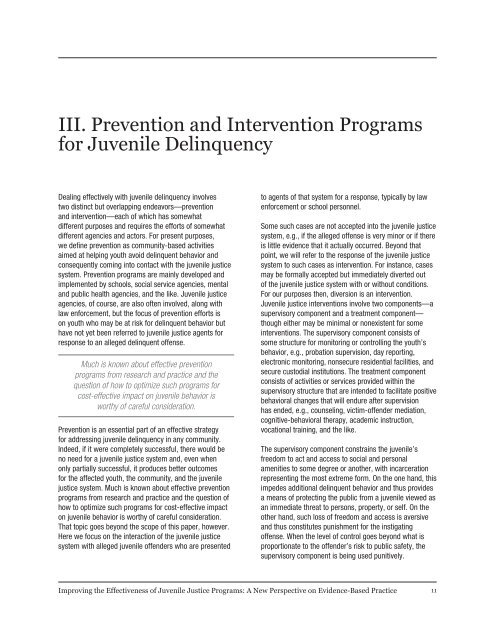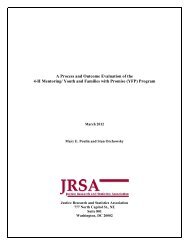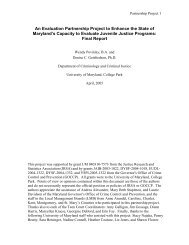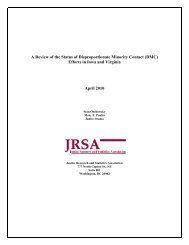Improving the Effectiveness of Juvenile Justice Programs: A New
Improving the Effectiveness of Juvenile Justice Programs: A New
Improving the Effectiveness of Juvenile Justice Programs: A New
You also want an ePaper? Increase the reach of your titles
YUMPU automatically turns print PDFs into web optimized ePapers that Google loves.
III. Prevention and Intervention <strong>Programs</strong><br />
for <strong>Juvenile</strong> Delinquency<br />
Dealing effectively with juvenile delinquency involves<br />
two distinct but overlapping endeavors—prevention<br />
and intervention—each <strong>of</strong> which has somewhat<br />
different purposes and requires <strong>the</strong> efforts <strong>of</strong> somewhat<br />
different agencies and actors. For present purposes,<br />
we define prevention as community-based activities<br />
aimed at helping youth avoid delinquent behavior and<br />
consequently coming into contact with <strong>the</strong> juvenile justice<br />
system. Prevention programs are mainly developed and<br />
implemented by schools, social service agencies, mental<br />
and public health agencies, and <strong>the</strong> like. <strong>Juvenile</strong> justice<br />
agencies, <strong>of</strong> course, are also <strong>of</strong>ten involved, along with<br />
law enforcement, but <strong>the</strong> focus <strong>of</strong> prevention efforts is<br />
on youth who may be at risk for delinquent behavior but<br />
have not yet been referred to juvenile justice agents for<br />
response to an alleged delinquent <strong>of</strong>fense.<br />
Much is known about effective prevention<br />
programs from research and practice and <strong>the</strong><br />
question <strong>of</strong> how to optimize such programs for<br />
cost-effective impact on juvenile behavior is<br />
worthy <strong>of</strong> careful consideration.<br />
Prevention is an essential part <strong>of</strong> an effective strategy<br />
for addressing juvenile delinquency in any community.<br />
Indeed, if it were completely successful, <strong>the</strong>re would be<br />
no need for a juvenile justice system and, even when<br />
only partially successful, it produces better outcomes<br />
for <strong>the</strong> affected youth, <strong>the</strong> community, and <strong>the</strong> juvenile<br />
justice system. Much is known about effective prevention<br />
programs from research and practice and <strong>the</strong> question <strong>of</strong><br />
how to optimize such programs for cost-effective impact<br />
on juvenile behavior is worthy <strong>of</strong> careful consideration.<br />
That topic goes beyond <strong>the</strong> scope <strong>of</strong> this paper, however.<br />
Here we focus on <strong>the</strong> interaction <strong>of</strong> <strong>the</strong> juvenile justice<br />
system with alleged juvenile <strong>of</strong>fenders who are presented<br />
to agents <strong>of</strong> that system for a response, typically by law<br />
enforcement or school personnel.<br />
Some such cases are not accepted into <strong>the</strong> juvenile justice<br />
system, e.g., if <strong>the</strong> alleged <strong>of</strong>fense is very minor or if <strong>the</strong>re<br />
is little evidence that it actually occurred. Beyond that<br />
point, we will refer to <strong>the</strong> response <strong>of</strong> <strong>the</strong> juvenile justice<br />
system to such cases as intervention. For instance, cases<br />
may be formally accepted but immediately diverted out<br />
<strong>of</strong> <strong>the</strong> juvenile justice system with or without conditions.<br />
For our purposes <strong>the</strong>n, diversion is an intervention.<br />
<strong>Juvenile</strong> justice interventions involve two components—a<br />
supervisory component and a treatment component—<br />
though ei<strong>the</strong>r may be minimal or nonexistent for some<br />
interventions. The supervisory component consists <strong>of</strong><br />
some structure for monitoring or controlling <strong>the</strong> youth’s<br />
behavior, e.g., probation supervision, day reporting,<br />
electronic monitoring, nonsecure residential facilities, and<br />
secure custodial institutions. The treatment component<br />
consists <strong>of</strong> activities or services provided within <strong>the</strong><br />
supervisory structure that are intended to facilitate positive<br />
behavioral changes that will endure after supervision<br />
has ended, e.g., counseling, victim-<strong>of</strong>fender mediation,<br />
cognitive-behavioral <strong>the</strong>rapy, academic instruction,<br />
vocational training, and <strong>the</strong> like.<br />
The supervisory component constrains <strong>the</strong> juvenile’s<br />
freedom to act and access to social and personal<br />
amenities to some degree or ano<strong>the</strong>r, with incarceration<br />
representing <strong>the</strong> most extreme form. On <strong>the</strong> one hand, this<br />
impedes additional delinquent behavior and thus provides<br />
a means <strong>of</strong> protecting <strong>the</strong> public from a juvenile viewed as<br />
an immediate threat to persons, property, or self. On <strong>the</strong><br />
o<strong>the</strong>r hand, such loss <strong>of</strong> freedom and access is aversive<br />
and thus constitutes punishment for <strong>the</strong> instigating<br />
<strong>of</strong>fense. When <strong>the</strong> level <strong>of</strong> control goes beyond what is<br />
proportionate to <strong>the</strong> <strong>of</strong>fender’s risk to public safety, <strong>the</strong><br />
supervisory component is being used punitively.<br />
<strong>Improving</strong> <strong>the</strong> <strong>Effectiveness</strong> <strong>of</strong> <strong>Juvenile</strong> <strong>Justice</strong> <strong>Programs</strong>: A <strong>New</strong> Perspective on Evidence-Based Practice<br />
11

















